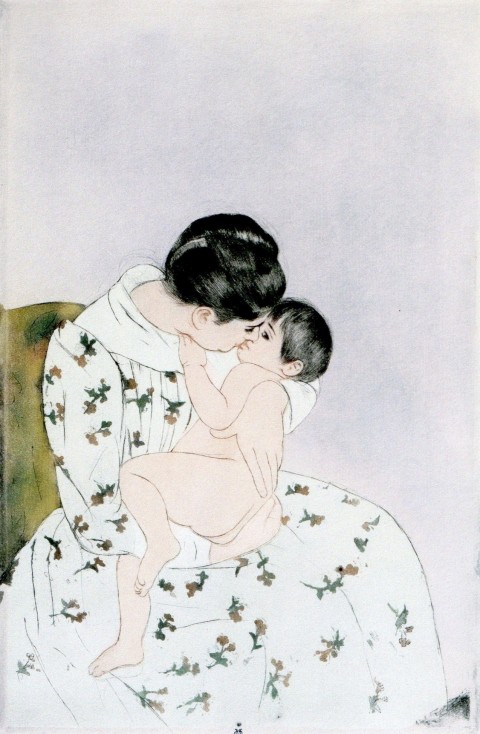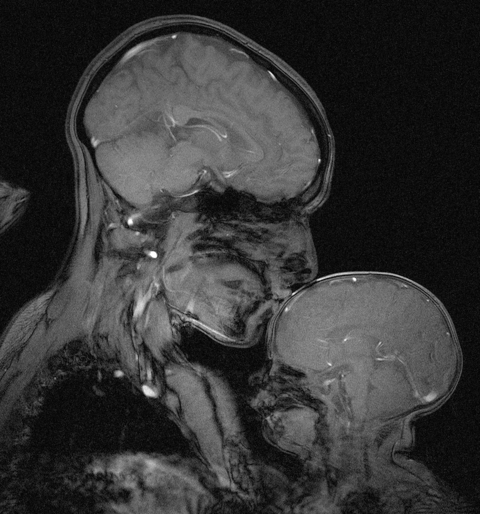A 21st Century Mother-and-Child
Thought I’d try one post this year without politics or snark, and this is it.
A couple of weeks ago I put this up at The Boston Globe‘s site — and it is, I believe, behind a pay wall. The Globe is kind enough to release the material back to me to post after a bit, as long as I credit and link back to the original posting (see what I did there) — so here it is. If the image has any resonance this time of year for you….good. And if what its maker has to say about the multiplication of possibilities it embodies adds a little joy to the picture? So much the better.
_________________________
A mother cradling her infant child.
If the better angels of human nature were to prevail, this picture could become one of those pictures — a single frame that captures an essential piece of the 21st century.
Two human beings, stripped way past bare: two brains, connected in a universal human pose, a mother cradling her infant child.
Rebecca Saxe, a neuroscientist (and my colleague) at MIT, is a maestro of the camera that can make such images, the functional magnetic resonance imaging machine, or fMRI. To create an fMRI portrait, a subject must lie still inside a narrow cylinder, the inside of a giant electromagnet. The artful manipulation of electromagnetic fields catches the brain in the act — not quite the act of thinking, but of working, nerve cells grabbing oxygen to power the action that ultimately adds up to an idea, a gesture, a feeling.
Making a functional magnetic resonance image demands a lot of its subjects. In a return to the earliest days of photography, you have to lie still for minutes to allow the fMRI machine to complete its tour of your skull. “Moving just a millimeter leaves a blur on the screen,” as Saxe writes at Smithsonian.com. “The mother and baby must hold their pose, as if for a daguerreotype.”
Saxe’s work centers on a fundamental question: How people grapple with the realization that other people have thoughts inside their heads — an area of research called “theory of mind.”
Becoming aware of the fact that people around you are thinking and learning to analyze what those thoughts might be, is a capacity that human beings develop over time — which has led Saxe to attempt to make fMRI images of ever younger children. That allows her to track how growing brains, growing people, form the ability to imagine the reality of other’s minds.
There’s no science in Saxe’s picture of herself with her son — or rather, there’s no data to be used in any formal extension of her theory of mind research. Instead, one reading of the image is simply as a marker, a measure of the current state of a scientific project. Saxe writes that the juxtaposition of her mature brain with the just-getting-started one of her son is the “depiction of one of the hardest problems in neuroscience: How will changes in that specific little organ accomplish the unfolding of a whole human mind?”
That is: This picture captures a key step in the process of discovery — the moment when a human invention extends the reach of human senses into realms that were until then not just unexplored but unreachable. New instruments don’t just reveal more of something, more detail, better precision, or what have you. Often, as here, they open windows onto whole new vistas. We’re a very long way yet from answering Saxe’s question, but in the sight of her and her son’s brains we can recognize that an answer is possible.
That’s reason enough to borrow an afternoon of scanner time — but that’s not the whole story behind this picture. Saxe says she and her colleagues made this particular fMRI image “because we wanted to see it.” She reads in it a specific story, an argument. Mother and Child is an old, old trope, in art and in human experience, and as Saxe writes, there is a reflex to elevate “the maternal values, and the women who embody them” to the exclusion of the possibility (or propriety) of those same women exercising their smarts in any out-of-the-home role.

Saxe with her son, depicted and depicting — as she writes, neuroscientist and mother — collude in the same single frame. That was the goal, to create “an old image made new.” And there it is, in the traditional gesture of a mother kissing her child, and the utterly new view of that caress from the inside out.
To me, for all that Saxe’s gloss is so clearly readable in her picture, there’s a yet broader idea expressed. There’s a lot of loose talk around the so-called two cultures of the humanities and sciences, often presented as two sharply distinct ways of making sense of the world. Saxe’s picture gives the lie to that simplistic framing. Art does many things, but certainly one of them is to give us images that confront us with shards of the strange experience of being human. Science, an artful craft, can do the same — as it does here.
_______________________
Back to regularly scheduled rage, weariness, snark, schadenfreude, celebrations of the discomfiture of our adversaries and random brain bubbles after this. Happy Saturnalia, all.
Image: Mary Cassatt, Mother’s Kiss, between 1890 and 1891.
Explore posts in the same categories: brain and mind, Cool Images, rare sincerity, UncategorizedTags: science
You can comment below, or link to this permanent URL from your own site.
January 6, 2016 at 2:37 pm
The Globe link isn’t quite right-
January 6, 2016 at 3:23 pm
Fix’t, at least on my machine. Yours? Thanks for letting me know, BTW.